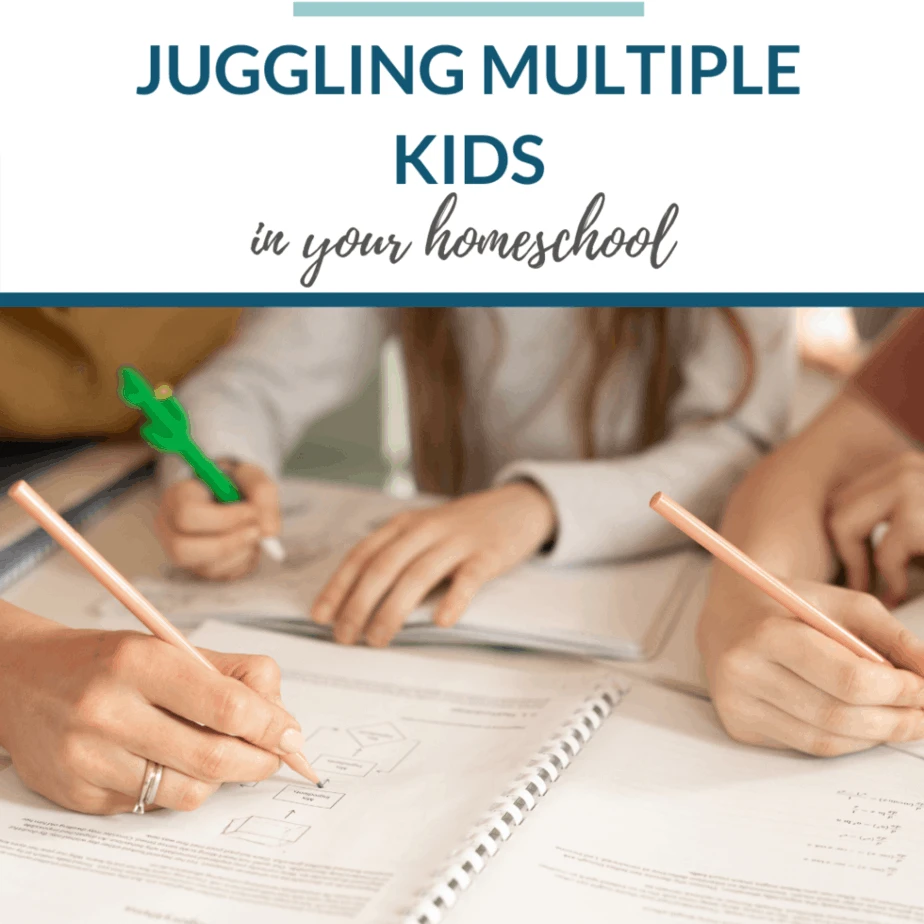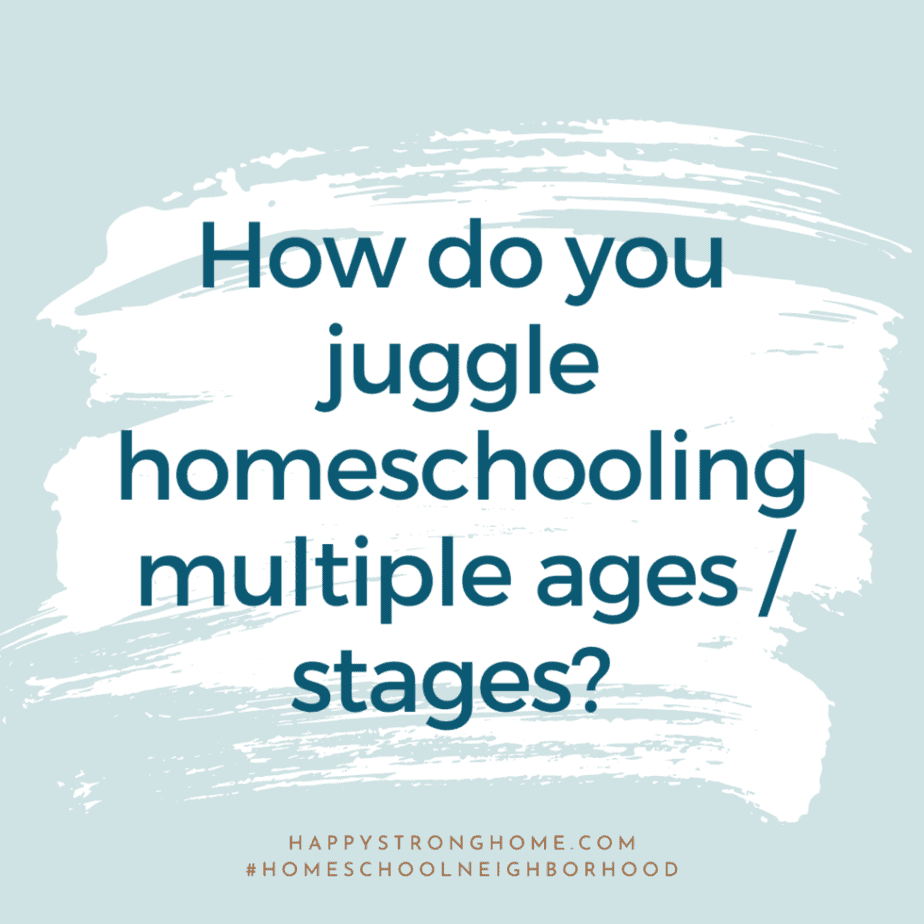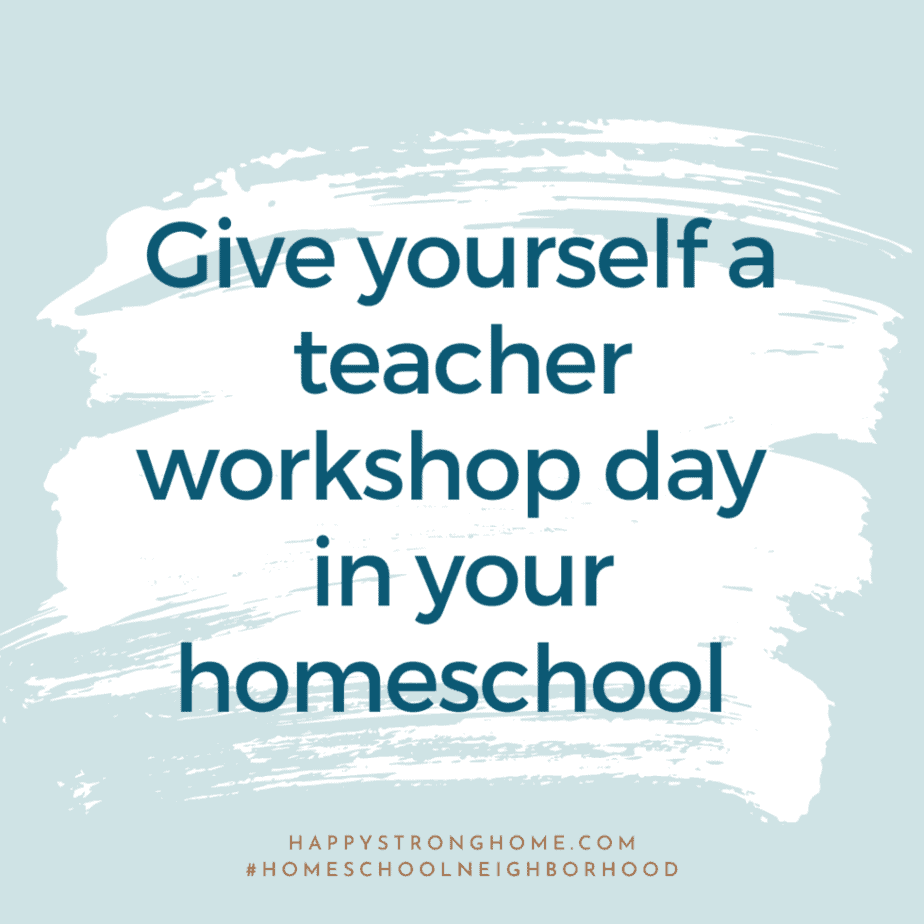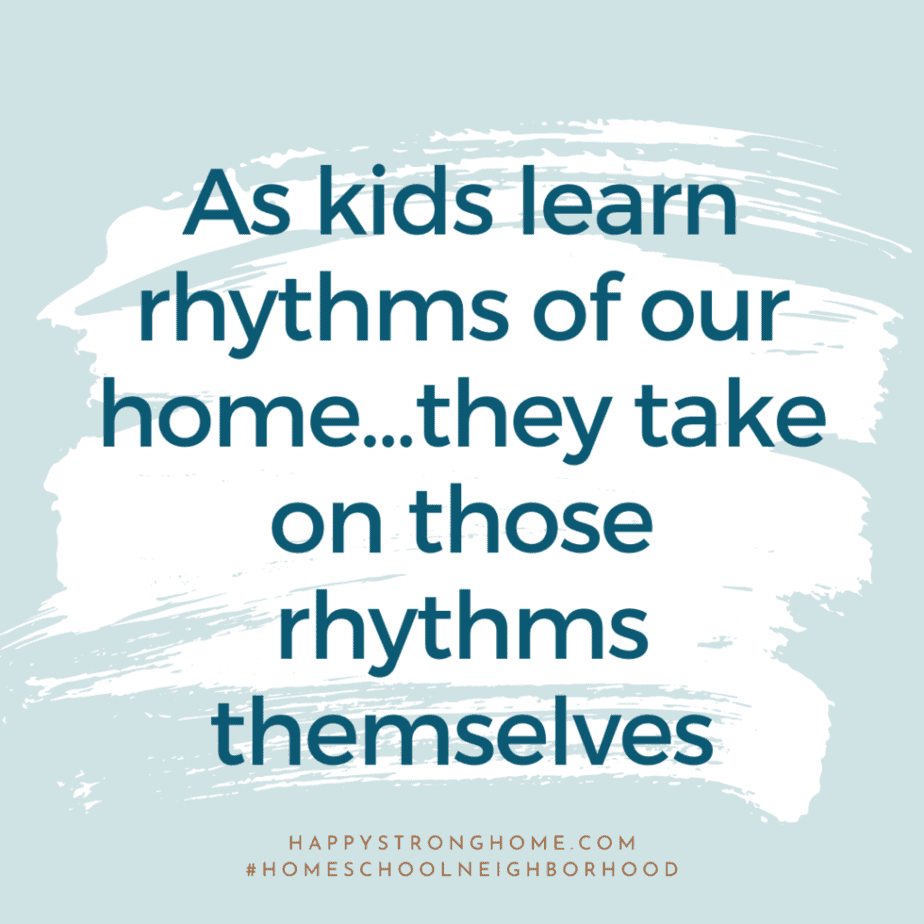As your family grows, so does your homeschool. So how do parents juggle homeschooling multiple kids that span a range of ages and stages?

Now I have two boys, so I seesaw between the two back and forth. Having just two kids does make my homeschool a little bit easier. So, last weekend I interviewed Tracey Oliver, homeschool mom of 5 and dear friend, to see what she’s learned over her years of home educating.
Tracey has a peaceful, calm, and beautiful way of homeschooling her kids. I admire watching her homeschool, and we have fabulous talks about how we manage homeschool life and try to bring joy and peace into our homeschools. She always has wonderful wisdom.
How to Juggle Homeschooling Multiple Kids
Watch our Interview here:
Or read the transcript here:
Julie: Tell us a little bit about yourself and your homeschool, your family, your kids.
Tracey: My husband and I decided to homeschool right from the start. We have five children, three girls and two boys ranging from three years old, up to 11 and everywhere in between. And so it really is a juggle I have things that I’m trying, but I’m still seeking advice and thinking through this as well. So I’m still in the midst of it. Definitely don’t feel like an expert, but have some things I think are going pretty well right now.
Julie: Every year you’re in a different scenario with kids at different stages and grades. Even if you’re using the same curriculum, you have a different student using it, so they respond differently. When I taught my boys to read, my oldest took off right away at four and a half years old. When I went to teach my second son to read with the same exact program, we slogged along, and I had to get a different program, take some breaks, regroup. Every child every year is different.

Looking at the Big Picture when Homeschooling Multiple Kids
So when you look at the big picture, what are you thinking about when you look at your year overall?
Tracey: I start by thinking about our family and talking with my husband. We call him our principal. We’re doing this together, even though I am the COO I’m carrying it out, but it’s both of our goals.
- What do you want for us as a family this year?
- What are some things that we’re seeing that we want to improve upon?
- What are some things that are going well?
Then I look at each [child] individually. So it’s really good to look at a family goal, but then also look at each of [child] individually.
- Where are they at?
- Where are we headed?
- How can I support them this year and get them to the next thing?
They all have different strengths and how they learn.

Julie: This goes back to not chasing shiny objects in your homeschool—buying this and that and the other thing. [Read about that here] You have to start with your core values. Once you know what you value, you can set a goal to embed those values into your homeschool year. And for each child, bring them along with what they need to grow into.
Tracey: Ultimately, when your kids leave your house–now this is big picture, this isn’t just year to year–what do you want for them? There’s so many different methods out there. There’s so many different curriculums, but ultimately they have to STEM from your core values and from what you ultimately want for your kids and your family.
Planning the Year for Homeschooling Multiple Kids
Julie: Then you then move into buying curriculum or getting your curriculum resources together for the year? Is that the next step?
Tracey: Yes. I have their goals and then I have a column saying: what am I going to use to achieve those goals in each of those subjects or whatever? And then I think about how are we going to get there, or what are we going to use to achieve that? So if that’s a curriculum or for us our library—I kind of poke at our local librarians and they’re wonderful—There’s so many good resources there too.
Julie: It sounds a lot like my own process in coming up with goals and then finding the resources. When you have your goals, you are not as likely to get that FOMO. I think that’s something every homeschool mom kind of figures out after a while.
The Day-to-Day Life for Homeschool Moms
But then you get into the year and there’s the the day-to- day. How does it work to not get overwhelmed? You’re working with math with one kid, and then another kid comes up “I can’t figure out my spelling.” And then another kid’s drawing on the walls? What is your day-to-day strategy?
Tracey: When we first started, I did all the conferences and I went to all those help classes, where they give you advice. I remember someone saying: write everything in pencil because you’re not going to get it all done. So it’s not etched in stone, right?
I plan my weeks in six week chunks. Give yourself a teacher workshop day. Every six weeks I take the day or a few hours and reset. I ask what’s going well? Keep this flow and keep these anchor points. Not reassessing not every day, because that would be really hard for the kids to change it up on them every week.
Give yourself six to eight weeks of trying something and then say, okay, how did that go?

Julie: A big frustration for homeschool moms is the daily interruptions. Do you have a strategy to avoid getting derailed?
Tracey: …Because the more kids, the more interruptions. It still throws me off. But it’s like complaining about the rain, right? It happens. It’s easy to say, here’s what I want to get done right now. I want us to sit for 20 minutes while I read.
The interruptions are going to happen. I still get surprised by it. I think it takes a while for everyone to get in a rhythm, but once we have what I call, our anchor points, they know the flow of our day.
The three-year-old’s always gonna have needs. If a kid gets up to grab a snack or use the restroom, I keep going, and they miss 15 seconds, but it’s okay. Sometimes you can’t stop every time something happens ‘cause that would throw everybody off.
And there are some things my older kids do independently, which is helpful for me to work with the younger kids. So I know in our flow of our day, we have times where we’re together, and then we have times where it’s independent work and my older kids come to me if they have questions or they show me when they’re done.
That was the biggest adjustment for me: being able to send off the older kids and trust that they’re gonna get those things done.I’m trying to instill in them the idea that this is theirs—it’s your life and it’s your learning. You’re not doing this for me.
Julie: It’s a very unique scenario we’re in as homeschoolers. I used to be a classroom teacher. So I’ve seen both worlds and never in my classroom teaching world, did a three-year-old walk into my classrooms! So remember, you’re in a unique situation.
I love what you said, the interruptions are going to happen. Expect them and treat them as a natural part of your school day.
The reality is a lot of the teaching we do spirals. We return to themes and topics and concepts over and over again. So our kids get the learning again another time.
We’re continually pouring learning and time into our kids. Plus, we have the flexibility also to stop when they don’t get something, if we realize the interruption has become too much.
I love what you said about rhythms. My goal for my kids is to become independent learners. As they learn rhythms of learning and our home, it’s easier for them to take on those rhythms themselves.

Getting Kids to Be Independent In Your Homeschool
Can you speak to some of your older kids having taken on independence in their learning.
Tracey: It was beautiful to see this: my older two are 10 and 11; they’re 15 months apart. So from when they were preschool age, I have been walking them along together in the same curriculum. And like with any subjects, you’re going to have some kids at different levels with different things, but so far I’ve been able to school them in a similar way with similar things. So that was helpful. This year I have put on a little bit more for them: here’s what you need to get done. You can do it in whatever order you want, as long as it gets done. I’m trying to see how they handle that.
Now, if I noticed they would rather me say, [do these things], then I would do that. But, if they want to start with English and then do math, that’s fine. Or do math first, everyday, it doesn’t matter. I’m trying to feel that out and see if they would thrive better planning on their own, or if they would rather be given the list.
Julie: Having a balance of sometimes directing their learning, and sometimes giving choices is what we call in teacher speak: scaffolding growth. You’re providing the framework they can rest upon and learn within.
I have a nearly 11 year old right now and I am amazed how independent he has gotten. Are are you finding it gets easier?
Tracey: Yes. So I was not homeschooled. My husband was, but I was not. So this is all new to me. That was one of the things I was curious to see ‘cause I kept hearing, “Oh, by the time homeschool kids are in high school, they’re just going to be doing it all by themselves.”
And I’m like, what does that look like? I didn’t have that experience.
I like that word that you used scaffolding, to set them up, to then pull it away. My oldest, my daughter, asked for her own assignment book this year. So once a week, we’ll sit down together and she loves that. She wants to write down what she has to do. And I told her, Hey, listen, this is what you have for the week. So, if you get it all done early because you want to play with a friend on Friday, then you have the day.
So seeing her take that on has been really cool. I know that’s not going to be all of my kids. Some are going to need a little bit more push, but it’s been nice to see her do that.

Balancing the Different Ages in Your Homeschool
Julie: You said although you’ve come up with ways that have been working for you with juggling different ages and grades there are still some things you’re working through and have questions about.
What are some of those questions?
Tracey: It’s more like goals for the younger kids. I think whenever we have children you kind of teach to the oldest. Because they’re your first, right? They got the new curriculum, everything’s brand new in teaching them and helping them out.
I need to be more consistent with giving my younger kids things to do. I’m trying to find the balance of how do I give them intentional things to do versus they’ll be fine if they’re just playing.
It’s actually lovely to see, because my three-year-old will sit at the laptop when one of my kids is working on math and she’ll watch them. And my six year old plays with her. He’s not sitting down as long as the older kids. So I think the expectations for how much they’re sitting down is going to be different with every age. It’s okay to sit down for 15 or 20 minutes with my six year old and do math and then say, okay, go play with your sister.
So knowing how to be a little more intentional with the younger kids, but at the same time, giving them space to play.
Julie: Even with having two, when I’ve gone to teach my younger child, he tells me he already knows it. It’s amazing what he’s absorbing when I’m teaching my oldest. And he’s sitting there, coloring or doing handwriting, he has actually been absorbing a lot of the core concepts of what we’re doing. So two years later, when I’m teaching it to him, he’s like, “Oh, I remember when you talked about, decimal points”—because he was absorbing all of that information that I was teaching my oldest.
So this is a perk of homeschooling– that one room classroom–they assimilate a lot of what is going on with the older students. As you said, we tend to teach up to the oldest student, but a lot of this valuable learning is trickling down. Not just the facts, but also the way we learn, this is how we learn.
Going back to the rhythms. You’re saying, what do I do for my younger students? With your older students you’re modeling how we learn, how we go about the process of learning. And they’re internalizing that, which is so valuable. It’s an experience not a lot of kids see in a traditional classroom, because they’re with peers and all in the same place, more or less. So it’s actually valuable that younger kids get to see older kids learning and how that happens.
Tracy, thanks so much for talking about what it’s like to juggle five kids in your homeschool. I know for you, it’s a joy, but I know you take on a lot of responsibility. Thank you for sharing your tips and wisdom and the grace you give yourself to start again.
If you have a homeschool question, go to happystronghome.com/Ask. Put in your question and we can plan a time to talk live. I’m sure that the same questions you have, many homeschool moms out there have as well!

WIN a Homeschool Giveaway Bundle!
To help you keep up with the juggle, I’ve put together a giveaway bundle that includes a range of materials to keep your homeschool fun and engaging with multiple kids:

- Potato Clock Experiment Kit – for those days you just need a little something extra
- 101 Easy Wacky Crazy Activities – fill your homeschool with fun all year!
- Note pad – keep track of all the small to-do’s
- 2 Sticker Packs – reward kids and track progress
- Set of 8 Reading Highlighter bookmarks – helps young or struggling readers stay focused on the line they are reading!
- BONUS: Pick ANY TWO items from my Homeschool Printables Shop on Etsy! I will email the files to you!
Enter in the form below:
a Rafflecopter giveaway

